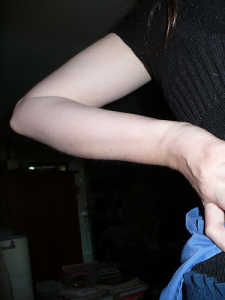
It is very common that some people will experience left sided back pain more frequently than the right side. This kind of pain can last for days, weeks and sometimes months. The location of this pain is usually below the ribs and around the side of the torso. This dull like and aching pain is usually more intense during particular hours of the day. Some people are very sensitive to touch in that area and some are sensitive to the dietary changes. Exercises, deep breaths and bowel movements can affect the pain on a left side of the lower back as well.
Many patients get frustrated because many times all of the tests come out negative. Prescription medication for pain might not be the solution to a problem. Some doctors will not have enough experience figuring out the cause of the pain. Ask your physician to refer you over to a specialist who has more experience with that kind of pain.
Here is a list of conditions which can cause lower left side back pain:
Ectopic pregnancy: A woman with a developing ectopic pregnancy may not display any signs or symptoms of being pregnant. Symptoms include lower abdominal pain, vaginal bleeding, cramping or stabbing pain around the pelvic area, dizziness and felling lightheaded.
Endometriosis: Symptoms may include pain in the pelvis, abdomen and lower back. Heavy flow of vaginal bleeding may accompany these symptoms.
Hypochondrial pain: Symptoms include pain under the rib cage, which can be referred from the colon or spleen.
Irritable Bowel Syndrome (IBS): Also known as spastic colon, IBS may be accompanied by abdominal pain, diarrhea, headaches, low back pain and chest pain.
Gastroesophageal Reflux Disorder: Symptoms may include heartburn, chest pain, back pain, difficulty swallowing or dry cough.
Pancreatitis: Symptoms that are chronic may include indigestion, abdominal pain, back pain, weight loss and steatorrhea (stool that is appears oily and foul smelling).
Peptic Ulcer: Symptoms may include a burning pain in the chest, nausea, vomiting, weight loss, change in appetite and back pain.
Gastrointestinal bleeding: Common causes include esophageal varices, stomach ulcer, erosions of the esophagus, duodenum or stomach; duodenal ulcer, abnormal blood vessels, colon cancer, anal fissures, colon polyps, diverticulosis, inflammatory bowel disease, internal hemorrhoids and inflammation of the large bowels.
Celiac Disease: Symptoms of celiac disease may mimic those of other conditions such as anemia, parasite infections, irritable bowel syndrome, gastric ulcers and skin disorders. Symptoms may include joint pain, weight loss, back pain, weakness and fatigue, bone disorders such as osteoporosis, diarrhea, abdominal cramps and anemia.
Radicular pain: This occurs when there is irritation or compression along the nerves exiting the spine. Symptoms include pain that is accompanied by weakness, numbness or a tingling sensation. Causes of radicular pain can be due to injury, trauma, soft tissue, disc herniation, facet syndrome or bony changes to the vertebral column.
Kidney stones: Symptoms include pain below the ribs, pain around the torso and back pain. It is also common to experience pain radiating into the lower abdomen and groin region. Other symptoms include pain during urination, nausea and vomiting.
Gallstones: Symptoms may include pain between the shoulder blades, pain in the center and upper right region of the abdomen, back pain and pain into the right shoulder. Additional symptoms may include abdominal pain after eating meals.
Problems with the adrenal gland: Common symptoms include headaches, dizziness when standing up or changing positions quickly, sensitivity to bright lights, low back pain.
